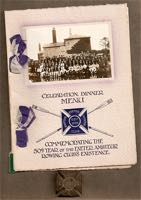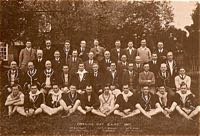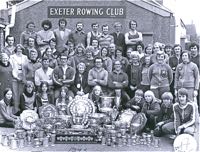
Exeter Rowing Club
Including other rowing clubs in Exeter
Researched and written by Anne McKechnie
Page added 8th June 2016
List of sports and sports centres
 1800 - 1946
1800 - 1946
It has often been said that Exeter Rowing Club was Devon’s first sporting club. However, it can be seen from the brief history which follows, that at times there have been several clubs rowing and competing on the Exe concurrently; and that, over the years, a number of them have come together to form Exeter Rowing Club as we know it today.
Isca Boat Club
There was an Isca Boat Club rowing the Exe in the early 1800s. In 1846 they won the Fours event at Teignmouth Regatta in a boat called ‘Dove’. Mr. Lansdown Harding of Willesdon, London, whose father was stroke in the boat, gave the winning trophy to EARC in 1940. His letter states that, as today, Exeter was not experienced in rowing on the sea and the Teignmouth boat was expected to win: “My father encouraged them in this by keeping a little in the rear until they were approaching the end, when he put on a spurt and they won at the post, much to the dismay of Teignmouth”.
According to the Western Times the race was rowed on 21 August 1846 attracted four entries for an amateurs’ rowing prize of £10.10s (10 guineas) given by the directors of the South Devon Railway Company (whose trains had brought 3,000 people to the Regatta). There were two boats from Exeter, the ‘Dove’ and the ‘Ariel’. The ‘Sylph’ and the ‘Annie Maria’ were entered by Teignmouth. The results were first ‘Dove’, second ‘Sylph’, third ‘Ariel’ and fourth ‘Annie Maria’. There was some dissatisfaction after the race and the other crews protested that the Dove ‘rounded the mark on the wrong side and had only gone round once’. The report in the Woolmar’s Exeter and Plymouth Gazette does not mention the protest, but does give more detail of the ownership of the boats. The Dove belonging to the Isca Boat Club, the Sylph to Teignmouth Scratch Crew, Ariel to Mr. Tuckett of Exeter and the Annie Maria to Mr. G Warren’s Crew. Unfortunately neither report gave the names of the crew members.
 Exeter Amateur Rowing Club
Exeter Amateur Rowing Club
Exeter Amateur Rowing Club was founded in 1864. The subscriptions of the 21 founder members were recorded in the Treasurer’s account book on 1st March that year.
The earliest Minute Book still held in Club records is number two, which dates from 1865, in which year the Club Rules were registered with the Register of Friendly Societies of England and the following people were contacted, inviting them to become Hon Members and Patrons:
Sir John Bowring
W C Nation
The Earl of Devon
Sir L Palk
Sir A J Acland
Lord Poltimore
Sir Stafford Northcote
S J Kekewick Esq
John Follett Esq
Hon Mr Pellow
Hon Mark Rolle
John Sillivant Esq.
They were probably asked to donate a sum of money for the privilege. One of the early Minute Book entries tells of John Henry Seager who was appointed Messenger for the Club at a salary £1 per year to be paid half yearly. Unfortunately by February 1866 the club could not afford to pay his salary and it is stated that he was prepared to work unpaid as long as he did not have to attend meetings!
Also in 1866 EARC received a letter from the Secretary of the Salmon Pool Rowing Matches. Which club, if any, organised these is not recorded.
The club’s badge was a Maltese Cross. One of the originals is still in the club’s archives (see image below) and the club’s first boat, an eight, was called the ‘St John of Malta’. They adopted the colours of white and mauve initially. However in 1868, according to the minute book, they rowed in all white. The club headquarters and boathouse were at the Port Royal Public House on the Exeter side of the river between the Quay and Trew’s Wear. In the exhibits on show at the Exeter Regatta Centenary plus dinner in April 1967, a picture of the ‘Whirlwind’ at the Port Royal in 1850 was presented to ERC by Geoffrey Pring. According to the Illustrated London News for 14 September 1850 ‘a mighty whirlwind on the Exe lifted boats off the river and over the cottages, depositing the boats on the fields rising behind them’.
The Port Royal was originally a warehouse and later a row of cottages, becoming a public house in the mid 18th century. There is still a landing stage outside the pub and the 1952 boathouse is now used as the ‘Boathouse Dining Room’.
In September 1928 the Club hit financial problems and it was decided to only keep two thirds of the dinghies and the tub pair. The rest of the boats were sold, as the funds were £23 in deficit.
A Port Royal ARC was formed in 1927 and seems to have shared the premises at the Port Royal until 1929 (see below).
In 1929 EARC moved out of the Port Royal Boathouse into makeshift premises erected on a piece of land above Exe Bridge, under the cattle market wall (on the Exeter bank in the vicinity of the north bridge). At Exe Bridge EARC built a dressing room at a cost of £3. One of the members (Marks) was asked to clean it twice a week.
By January 1930 they had plans for new boathouse but had to get a new raft to replace the one lost in December 1929 floods. Rowing and regattas in Exeter continued until 1939. The following comment was made about the regatta held on 24 July 1939 ‘following wind and swollen river made for fast times. Entries for Lads under 20 Novice were affected by the calling up of youth for Military Service’.
In 1945 the then chairman of the EARC J.M. Hodges in a letter to a newspaper states that the clubhouse was in a poor state due to war damage and lack of repair as 95% of the club members were serving in the armed forces. He had a vision of the club having an imposing new clubhouse on the site. The Exeter Amateur Rowing Club continued with mixed fortunes until the following year.
Exeter Mechanics Rowing Club
The EARC Minute Book 1865-1870 records that on 5 December 1865 it was proposed to invite the Secretary of the Exeter Mechanics Rowing Club to the annual dinner. Nothing further is known about the Exeter Mechanics Rowing Club.
Exonia Boating Club
It is stated in the EARC minutes for August 1866 that a letter had been received from the Exonia Boating Club asking if there would be a prize for Amateurs in the forthcoming regatta. Today all rowing competitions are Amateur but there were at the time competitions for men whose living was rowing. Exonia Boating Club was again mentioned in May 1869.
In 1869 a Challenge [to race] was sent to Exonia Boating Club, but was declined as EARC had ‘on two occasions this year declined friendly competition’.
St Thomas Amateur Rowing Club
There was a Rowing Club in St Thomas from 1893 until the early 1920s. An undated letter from Cecil C Plimsole of Buddle Lane, Exeter, and printed in the local press, tells of a photo that had appeared in the paper showing the club as winners of the West of England Junior Championship in 1898. One member of the crew was his father.
The photograph was taken up river from Exe Bridge, showing the houses that stood adjacent to the Royal Oak. The programme from the Totnes and Bridgetown Regatta of 1898 gives the name of the boat as ‘Iris’ and states that the crew of F Plimsole, A Stokes, S Hunt, H Clements and M Marks (cox), rowed in navy blue and gold strip.
The St Thomas boathouse was Thames-like in its surroundings and construction, situated on the riverside above the Exe Bridge and opposite the cattle market in Bonhay Road.
In 1907, 1908 and 1909, the Marks & Dorothy crew (pictured below) won the Bideford Senior IV Championship Cup. The Trophy had been given by John Henry Lile D.L.C.C. residing in London, a native of Bideford, and was know as the Lile Challenge Cup. The Cup is kept in the Guildhall in Exeter.
In 1914 all Regattas were cancelled after Totnes as War was declared and crews enlisted. In October, EARC received a letter from the Secretary of St Thomas Rowing Club stating that they were selling all their boats and property. At the next meeting the EARC committee felt they could not put forward a recommendation for purchase of the boats, etc, due to ‘the seriousness of the present situation [War] and the state of the club funds’. The boats were eventually bought from the St Thomas RC Trustees in 1923. The First World War was the cause of the demise of St Thomas RC.
Port Royal Amateur Rowing Club
The Port Royal Amateur Rowing Club was formed in 1927 and continued until merging with EARC to form Exeter Rowing Club in 1946. It must have shared the premises at the Port Royal until EARC moved out in 1929.
In May 1987 a photo appeared in the Express and Echo of the male club members at the Turf ‘61 years ago’. The members pictured included:- Walt Dart, Bill Ball, Fred Lee, George and Stan Neal, Charlie Green, Fred Dorothy, Bill Langmaid, Fred Densham, Cliff Godfrey, Harold Fisher, George Williams, Las Jordan, Ern Packham, Edgar Lee and coxes Matt Emery, Bill Gidley and Martin O’Neal. Apparently there was also a Ladies’ crew at this time, although they are not in the photograph.
Exeter Rowing Club
Exeter Amateur Rowing Club and Port Royal Amateur Rowing Club served two entirely different social groups. The EARC were ‘white collar’ enthusiasts where as PRARC were artisans – indeed, it is possible that they may have been formed from the Exeter Mechanics’ Rowing Club, although there is no evidence to support this.
There was a spirit of intense friendly competition between the two clubs and, in time, perhaps because of the 1939 war, there was a feeling that the clubs should amalgamate so the best rowers could row together for Exeter.
Hence in 1946, the two clubs became Exeter Rowing Club, dropping the word Amateur from the title. The tenancy of the landing stage in Bonhay Road was terminated in May 1946 and the headquarters returned to the Port Royal. A new club badge was designed, shown below.
│ Top of Page │











